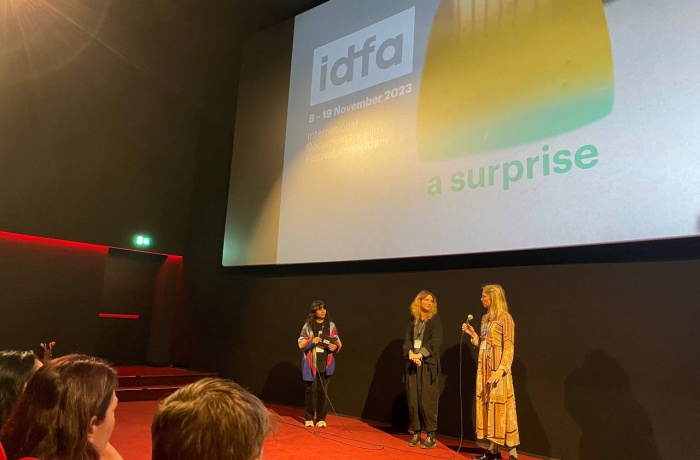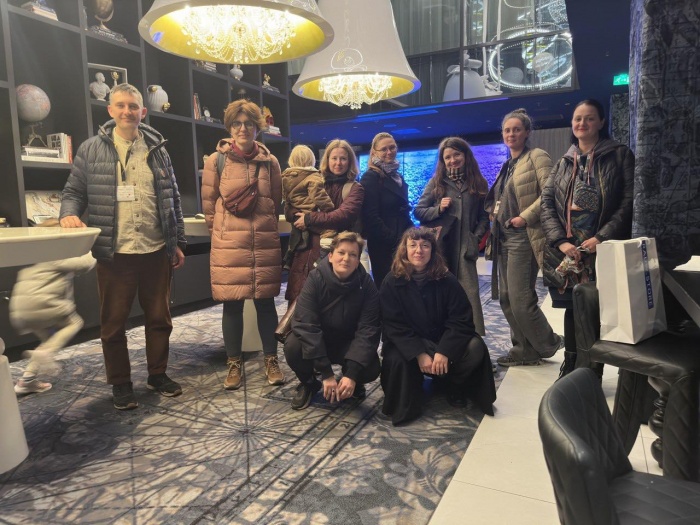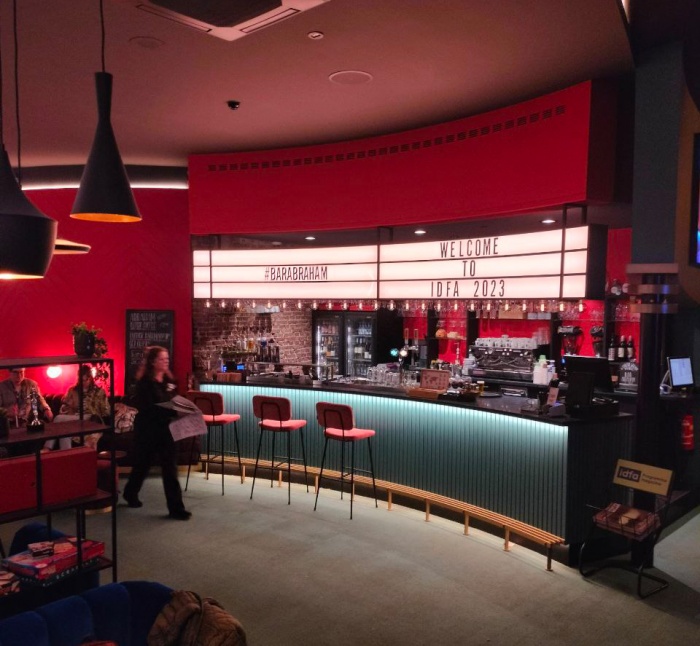
The IDFA Film Festival stands tall as one of Europe's grand stages for documentary cinema. We caught up with the Docudays UA team on their experience at the International Documentary Film Festival in Amsterdam—the events they attended, the Ukrainian community's visibility, and the fruits of their labor.
Yulia Kovalenko, Docudays UA Programme Director
I think that the most important and valuable experience of this year's IDFA is the impossibility of sitting on the sidelines when global shifts are underway. Right from its first day, the festival unfolded in a rather turbulent atmosphere of a platform where art is reclaiming its political role. Believe it or not, there is simply no room for a comfortable distancing game. It's a real challenge for the festival organizers, and I think the IDFA team stepped up admirably. The world is changing, the old order is collapsing before us, and we have to build a new one. Ukrainians are no strangers to this scenario, of course. It is a reminder that there is substantial work ahead if we want to secure our place in this new and still very fragile world.
The Ukrainian film “A Picture to Remember,” directed by Olha Chernykh, was the opening night feature. Another Ukrainian film, “20 Days in Mariupol,” won the Audience Award among 142 documentaries. The Ukrainian project “Militantropos” was awarded in the IDFA Forum's industry section. Overall, it's a promising display of Ukrainian documentary films at the festival. At the very least, we can say there is a steady interest in our films. However, there is room for growth. For instance, several presentations of Ukrainian works at the IDFA Forum were grouped into a single section. There is an ongoing discussion within the Ukrainian film community about the drawbacks of consolidating Ukrainian films and projects into distinct sections and selections. This trend is seen as potentially harmful, almost pushing Ukrainian cinema into a specific thematic “ghetto.”
To be honest, I only catch a few films on the big screen during festivals; my time is usually occupied with industry meetings and events. IDFA brings together people from every corner of the globe—a unique space to connect with potential new partners spanning continents.
In particular, this is a fantastic opportunity to nurture the cultural and diplomatic direction, especially crucial for us now, in my opinion. I won't get ahead of myself, but I hope our return from IDFA in this regard won’t be in vain. We have preliminary agreements that we aim to shape into exciting projects in the coming year.
Darya Averchenko, Head of the Docudays UA Communications Department
This year, it's great to see a substantial Ukrainian delegation at IDFA—a strong community that coordinates through a shared chat, offering support to ensure no one misses out on significant events.
It's fantastic to see the rise of new professionals and the emergence of fresh names. Take, for instance, documentary filmmaker Olha Chernykh from Donetsk, the creator of the opening film “A Picture to Remember.” This marks her debut in feature-length filmmaking, an essay film dedicated to her parents and grandmother, who remained in Donetsk. It's a very tender film of good artistic quality.
I also got to watch a new film by Alisa Kovalenko and Simon Lereng Wilmont, “A Girl Away From Home.” It's the story of a young gymnast from the Deriuhin School forced to relocate to Germany with her grandmother due to the war. I immediately invited this film to screen at Docudays UA, aiming to inspire our young audience not to lose hope and to seek stability within themselves and their passions.
I'm glad that I could dedicate half a day to delving into the Documentary Reality Lab and various digital media. Each year, IDFA hosts one of the largest programs in this domain known as DocLab. This year, it featured a discussion on artificial intelligence, exploring the benefits and threats looming in the near future. All sessions were fully booked, and tickets were sold out. What stood out to me was the interactive aspect of some works; it wasn't just about passive contemplation with VR glasses. For instance, there was a treadmill installation with a real mouse trainer, which made me rethink our perception of animals. 
Photo from the IDFA Facebook archive
Educational projects were abundant, with many tackling the issue of racism. In particular, one of the works immersed us in this context through the story of a black girl from Brazil who faces bullying at school.
The nature of bullying faced by black children in Brazilian schools was revealed in a short film with the sounds of the Amazonian jungle. From the 16th to the 19th centuries, kidnapped Africans were brought to the shores of Brazil to be sold as slaves to white colonizers. Most black slaves ended up in Brazil, and it was the last South American country to abolish slavery. Even today, albeit in hidden forms, exploitation and forced labor persist. The new digital media section seems to be the swiftest medium for delivering painful messages to the world.
We had a meeting with Isabel Arrate Fernandez, the Executive Director of the IDFA Bertha Fund, to discuss our open letter regarding the inclusion of a Russian film in the IDFA program, along with factual errors in its annotation. Isabelle noted that their foundation was established to support filmmakers worldwide without discrimination based on nationality. However, she assured us of her genuine support for Ukrainian documentary filmmakers. She made it clear that the IDFA team will not financially back or include Russian films in the festival program if they are funded by the Russian state budget or propagate propaganda narratives.
I would also like to suggest that the festival and the foundation consult Ukrainian experts to avoid making sensitive mistakes and to identify potential propaganda narratives early on.
Regarding the film “Mud” by Russian director Ilya Pavolotsky, the subject of our letter, turned out to be a black-and-white cinematic metaphor. It portrays patients in Russian mud baths either smearing mud or washing it off. Hopefully, the film suggests a desire for atonement, as the opening title also implies: “It was the second year of the Russian invasion of Ukraine…” Perhaps this veiled form of atonement might convince a Western audience, but for a person from our context, it appears as an inability to express a clear and understandable position, akin to their vague slogan “no war.”
Darya Bassel, Head of the DOCU/PRO Industry Platform
I attended this year's festival as a producer with two projects in different sections of the IDFA Forum: Iryna Tsilyk's “Red Zone” (animation) and Olha Zhurba's “Displaced” (working title). So for me, these days were very intense, filled with meetings and presentations at the industry market. I was thrilled to be at IDFA. For some reason, this year I felt a sense of returning home, to my family, to my documentary home.
Of course, the discussions about Israel and Palestine were prevalent at IDFA, and the events at the opening only fueled and intensified these conversations. Many of my foreign colleagues asked if I felt sad that Palestine was in the spotlight and if I saw parallels between russia's war against Ukraine and the Israeli-Palestinian war. I had to explain that the historical contexts are very different. In addition, for some reason, it is often overlooked that the full-scale phase of the russian-Ukrainian war began with russia's invasion, while the war between Israel and Palestine began with Hamas's attack on Israel. There was a palpable tension as people navigated their positions on the events in Palestine and Israel, and emotions ran high.
For the second year in a row, IDFA has been extending invitations and providing financial and organizational support to Ukrainian filmmakers. This year, the Ukrainian representation was significant. It's gratifying because I remember when only my colleagues from Docudays UA and I were the sole Ukrainians at the festival, with, at best, one or two directors. So now, when Ukraine has two projects at the forum, five works in the section presenting films in production, several films in the festival program, and a delegation of producers organized by the Ukrainian Institute, it's remarkable. Ukraine made a strong presence, and I see that the interest in our documentary cinema is enduring.
Darya Levchenko, Docudays UA Programmer
IDFA is a massive event, drawing programmers from most of the major documentary film festivals across Europe, Asia, and the Americas. It's a well-organized affair with a diverse array of films to watch. However, the real gem lies in distributors and industry events for networking. Being part of a community of film curators who grapple with the pains and challenges of selecting films in our unpredictable world is a rare luxury.
In my opinion, Ukraine managed to be seen and heard even though all the attention of documentary filmmakers was focused on the Israeli-Palestinian conflict. This is the result of years of meticulous work by the Ukrainian film community, systematically paving the way for cultural diplomacy at key European festival events.
I had the privilege of spending my time exclusively in Amsterdam's cinemas, aside from meetings. Exploring the city during the festival is an extraordinary experience in itself—traveling from one cinema to another by ferry, tram, and bicycle. The entire cityscape transforms into a film set where Ukrainian is heard on the streets as if back home, creating a sense of being both at home and on a completely different planet.
I had the chance to watch a variety of films—short and feature lengths, archival pieces, hits, and some that could potentially be included in the DOCU/YOUTH selection. In total, I watched 12 films, had 10 meetings with distributors, and attended 5 networking events, establishing long-term partnerships.
The dedicated section for young viewers stood out—a separate award and its own competition. It's a compelling approach to engage a younger audience. Overall, exploring how programs are compiled and organized, the attention to selections, and the balance between audience and niche documentaries provided valuable insights—a sort of learning best practices of programming “in the fields.”
The festival also has an excellent automatic system with daily reminders about upcoming screenings for the ticket purchaser. We will definitely incorporate some of the organizational experience from our colleagues at IDFA to make Docudays UA 2024 even more vibrant and accessible for diverse audiences.
Photo: Darya Averchenko, Darya Levchenko